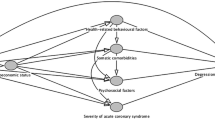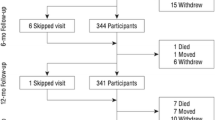Abstract
Objective
The objective of this prospective study was to determine the impact of depressive symptoms on long-term survival in coronary heart disease (CHD) patients treated with intracoronary stenting.
Methods
Four hundred and seventy patients completed the Hospital Anxiety and Depression Scale (HADS) before undergoing stent implantation and were followed over a 5-year period. Survival data were collected from n = 462 participants (98.3 %). A cut-off ≥8 on the HADS depression subscale was used to indicate probable clinical levels of depression.
Results
All-cause mortality rates differed significantly between depressed and non-depressed patients at 2-year follow-up, as 6 out of 98 subjects with elevated HADS-D scores (6.1 %), but only 8 out of 364 (2.2 %) patients with normal HADS-D scores had died [odds ratio = 2.9, 95 % confidence interval (95 % CI) = 1.0–8.6, p = 0.044]. In a Cox regression model adjusted for sociodemographic and clinical parameters, positive HADS-D scores [hazard ratio (HR) = 4.3, 95 % CI = 1.2–15.4, p = 0.025], body-mass index (HR = 0.8, 95 % CI = 0.7–1.0, p = 0.040) and stent length (HR = 1.1, 95 % CI = 1.0–1.1, p = 0.042) independently predicted 2-year survival. From the third to the fifth year after index PCI, the frequency of deaths in the depressed patients’ group did not significantly differ from that observed in non-depressed patients (5.5 % versus 7.0 %, p = 0.607), and the predictive role of baseline HADS-D scores for survival was lost.
Conclusion
In CHD patients, self-rated depressive symptoms at baseline were negatively linked to survival at 2-year follow-up, but failed to predict mortality 3 years later. Thus, in contrast to other well-established risk factors, the prognostic value of depression for predicting adverse outcome may be temporarily limited. The mechanisms behind this transient effect need further study.

Similar content being viewed by others
References
Wulsin LR, Singal BM (2003) Do depressive symptoms increase the risk for the onset of coronary disease? A systematic quantitative review. Psychosom Med 65:201–210
van Melle JP, de Jonge P, Spijkerman TA, Tijssen JG, Ormel J, van Veldhuisen DJ, van den Brink RH, van den Berg MP (2004) Prognostic association of depression following myocardial infarction with mortality and cardiovascular events: a meta-analysis. Psychosom Med 66:814–822
Nicholson A, Kuper H, Hemingway H (2006) Depression as an aetiologic and prognostic factor in coronary heart disease: a meta-analysis of 6362 events among 146 538 participants in 54 observational studies. Eur Heart J 27:2763–2774
Schowalter M, Gelbrich G, Störk S, Langguth JP, Morbach C, Ertl G, Faller H, Angermann CE (2013) Generic and disease-specific health-related quality of life in patients with chronic systolic heart failure: impact of depression. Clin Res Cardiol 102:269–278
Jiang W, Krishnan R, Kuchibhatla M, Cuffe MS, Martsberger C, Arias RM, O’Connor CM, SADHART-CHF Investigators (2011) Characteristics of depression remission and its relation with cardiovascular outcome among patients with chronic heart failure (from the SADHART-CHF Study). Am J Cardiol 107:545–551
Sherwood A, Blumenthal JA, Hinderliter AL, Koch GG, Adams KF Jr, Dupree CS, Bensimhon DR, Johnson KS, Trivedi R, Bowers M, Christenson RH, O’Connor CM (2011) Worsening depressive symptoms are associated with adverse clinical outcomes in patients with heart failure. J Am Coll Cardiol 57:418–423
Barefoot JC, Helms MJ, Mark DB, Blumenthal JA, Califf RM, Haney TL, O’Connor CM, Siegler IC, Williams RB (1996) Depression and long-term mortality risk in patients with coronary artery disease. Am J Cardiol 78:613–617
Barefoot JC, Brummett BH, Helms MJ, Mark DB, Siegler IC, Williams RB (2000) Depressive symptoms and survival of patients with coronary artery disease. Psychosom Med 62:790–795
Barth J, Schumacher M, Herrmann-Lingen C (2004) Depression as a risk factor for mortality in patients with coronary heart disease: a meta-analysis. Psychosom Med 66:802–813
Pedersen SS, Denollet J, Daemen J, van de Sande M, de Jaegere PT, Serruys PW, Erdman RA, van Domburg RT (2007) Fatigue, depressive symptoms, and hopelessness as predictors of adverse clinical events following percutaneous coronary intervention with paclitaxel-eluting stents. J Psychosom Res 62:455–461
Frasure-Smith N, Lespérance F (2008) Depression and anxiety as predictors of 2-year cardiac events in patients with stable coronary artery disease. Arch Gen Psychiatry 65:62–71
Pedersen SS, Denollet J, de Jonge P, Simsek C, Serruys PW, van Domburg RT (2009) Brief depression screening with the PHQ-2 associated with prognosis following percutaneous coronary intervention with paclitaxel-eluting stenting. J Gen Intern Med 24:1037–1042
Damen NL, Versteeg H, Boersma E, Serruys PW, van Geuns RJ, Denollet J, van Domburg RT, Pedersen SS (2013) Depression is independently associated with 7-year mortality in patients treated with percutaneous coronary intervention: results from the RESEARCH registry. Int J Cardiol 167:2496–2501
Hemingway H, Marmot M (1999) Psychosocial factors in the aetiology and prognosis of coronary heart disease: systematic review of prospective cohort studies. BMJ 318:1460–1467
Herrmann C, Brand-Driehorst S, Buss U, Rüger U (2000) Effects of anxiety and depression on 5-year mortality in 5,057 patients referred for exercise testing. J Psychosom Res 48:455–462
Bjelland I, Dahl AA, Haug TT, Neckelmann D (2002) The validity of the Hospital Anxiety and Depression Scale. An updated literature review. J Psychosom Res 52:69–77
Zigmond AS, Snaith RP (1983) The Hospital Anxiety and Depression Scale. Acta Psychiatr Scand 67:361–370
Herrmann C (1997) International experiences with the Hospital Anxiety and Depression Scale. A review of validation data and clinical results. J Psychosom Res 42:17–41
Spinhoven P, Ormel J, Sloekers PP, Kempen GI, Speckens AE, van Hemert AM (1997) A validation study of the Hospital Anxiety and Depression Scale (HADS) in different groups of Dutch subjects. Psychol Med 27:363–370
Meyer T, Hussein S, Lange HW, Herrmann-Lingen C (2013) Anxiety is associated with a reduction in both mortality and major adverse cardiovascular events five years after coronary stenting. Eur J Prev Cardiol (in press)
Herrmann C, Brand-Driehorst S, Kaminsky B, Leibing E, Staats H, Rüger U (1998) Diagnostic groups and depressed mood as predictors of 22-month mortality in medical inpatients. Psychosom Med 60:570–577
Denollet J, Pedersen SS, Daemen J, de Jaegere P, Serruys PW, van Domburg RT (2008) Reduced positive affect (anhedonia) predicts major clinical events following implantation of coronary-artery stents. J Intern Med 263:203–211
Carney RM, Rich MW, Freedland KE, Saini J, teVelde A, Simeone C, Clark K (1988) Major depressive disorder predicts cardiac events in patients with coronary artery disease. Psychosom Med 50:627–633
Pedersen SS, Denollet J, van Gestel YR, Serruys PW, van Domburg RT (2008) Clustering of psychosocial risk factors enhances the risk of depressive symptoms 12-months post percutaneous coronary intervention. Eur J Cardiovasc Prev Rehabil 15:203–209
Sullivan MD, LaCroix AZ, Spertus JA, Hecht J, Russo J (2003) Depression predicts revascularization procedures for 5 years after coronary angiography. Psychosom Med 65:229–236
Rothenbacher D, Hahmann H, Wüsten B, Koenig W, Brenner H (2007) Symptoms of anxiety and depression in patients with stable coronary heart disease: prognostic value and consideration of pathogenetic links. Eur J Cardiovasc Prev Rehabil 14:547–554
Kornerup H, Zwisler AD, Prescott E, DANREHAB Group (2011) No association between anxiety and depression and adverse clinical outcome among patients with cardiovascular disease: findings from the DANREHAB trial. J Psychosom Res 71:207–214
Acknowledgments
The authors particularly thank Dr. Mohammad N. Pasalary, Bremen, for expert assistance in data acquisition.
Conflict of interest
CHL receives royalties from Hans Huber Publishers, Berne, for the German version of the HADS. The remaining authors declare no conflict of interest.
Author information
Authors and Affiliations
Corresponding author
Rights and permissions
About this article
Cite this article
Meyer, T., Hussein, S., Lange, H.W. et al. Transient impact of baseline depression on mortality in patients with stable coronary heart disease during long-term follow-up. Clin Res Cardiol 103, 389–395 (2014). https://doi.org/10.1007/s00392-014-0666-6
Received:
Accepted:
Published:
Issue Date:
DOI: https://doi.org/10.1007/s00392-014-0666-6




